
Understanding Beach Signs
The Ocean Safety and Lifeguard Services Division developed beach signs to alert and warn beachgoers of hazardous conditions in posted areas. Some signs are permanent fixtures, while others are posted daily, based on beach and ocean conditions.
Although danger warnings and signs may not appear to be serious to some people - THEY ARE! If you are unsure about what the signs mean or have any other questions regarding the ocean conditions during your day at the beach, please ASK A

Identifying Beach Signs
Use the images and information below to identify the beach signs you see at the beach.
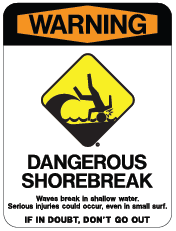
Dangerous Shorebreak
This is an ocean condition when waves break directly onshore. Shorebreaks are unpredictable and dangerous. They cause serious neck and spinal injuries to both experienced and inexperienced bodysurfers and swimmers. Small and high surf can be equally dangerous and can cause serious injury or death. Be sure to ask a lifeguard about the wave conditions at the beach before going into the water. Common shorebreak beaches: Sandy Beach, Waimea Bay, ʻEhukai, Makapu'u and Mākaha.
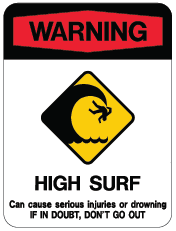
High Surf
Many coastal areas of rock and sandstone are covered by a thick moss. Use extreme caution when walking along these slippery areas as severe injury or worse may result from a fall.
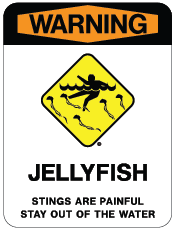
Jellyfish
Box Jellyfish regularly swarm to Hawaiʻi's south and leeward shores 9 to 10 days after the full moon. Carybdea alata cause the most "nuisance" for beachgoers in Hawaiʻi. Don't go into areas where sighted, or if dead box jellyfish are seen on the beach. Observe posted signs. Symptoms of a sting include stinging, burning, redness, swelling of lymph nodes and in cases of severe reactions may result in difficulty with breathing, symptoms of shock and cardiac arrest.
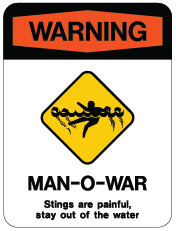
Portuguese Man-o-war
Portuguese man-o-war are most commonly found along bays and beaches during strong onshore winds. They are high in number when winds blow in from the ocean onto land, so beachgoers are urged to observe posted signs. Symptoms of a sting include stinging, burning, redness, swelling of lymph nodes. If stung carefully pick off any visible tentacles. Rinse with fresh or saltwater. Apply ice for pain. IMMEDIATE medical attention may be required for severe reactions.
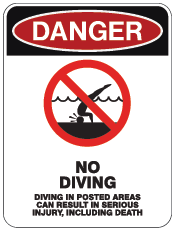
No Diving
Serious, debilitating injuries and permanent injuries can occur as a result of diving into shallow or unknown waters and striking the bottom. Check for depth and submerged objects before diving. Do not dive into shallow water. ALWAYS THINK FIRST!
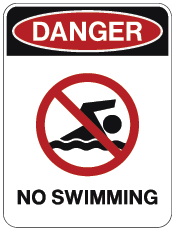
No Swimming
No swimming signs are posted by lifeguards to advise beachgoers of extreme life-threatening conditions. DO NOT ENTER WATER WHEN THESE SIGNS ARE POSTED!
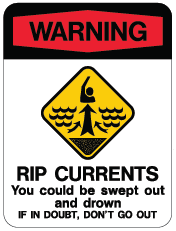
Rip Currents
Rip currents are powerful, narrow channels of fast-moving water that can quickly get swimmers into trouble. Panicked swimmers often try to counter a rip current by swimming straight back to shore. The best thing to do when you find yourself in a rip current is to swim parallel to the shore until you free from the pull of the current, then make your way into shore at an angle. Do your best to stay calm.
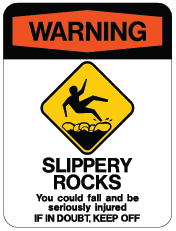
Slippery Rocks
Many coastal areas of rock and sandstone are covered by a thick moss. Use extreme caution when walking along these slippery areas as severe injury or worse may result from a fall.
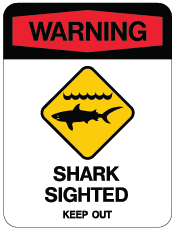
Shark Sighted
Shark sighted signs are posted when a shark sighting is confirmed by Ocean Safety Lifeguards, or another reliable source. Do not enter the water in areas where signs are posted. If you see or encounter a shark notify Ocean Safety personnel or call 911 immediately.

Sharp Coral
Most of Hawaiʻi's beaches have sharp coral reefs close to the shoreline. Use caution when swimming in shallow reef areas. Foot protection is advised. Should you be injured, see a lifeguard for minor first aid assistance. Should coral become deeply embedded, see your doctor as soon as possible to have it removed. Deep cuts should be attended to by a physician to avoid the risk of infection.
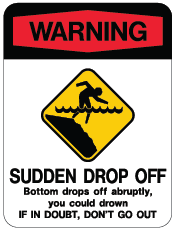
Sudden Drop Off
Water depth can change abruptly, from wading depth to over your head. Avoid ledges and drop-offs, especially if you are not a strong swimmer. Beware of strong currents which commonly run parallel to drop off areas.

Strong Current
These are swift moving channels of water that are difficult to swim against. Strong currents frequently accompany high surf and rapid tide changes and can be recognized as a turbulent channel of water between areas where waves are breaking. When caught in a strong current -- Try to keep a level head, i.e., don't panic! Wave one or both hands in the air, and scream or call for help. Swim diagonally across the current, not against it.
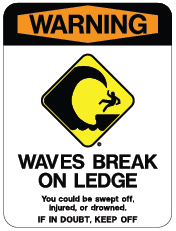
Waves Break on Ledge
These are large waves originating from deep water breaking on rock ledges. However, this condition can occur even when the water appears to be calm. Be very cautious when walking along rocky coastlines where waves are breaking. Rocks become slippery and are sharp, abrasive lava stones. The ocean is unpredictable and has been known to wash people away. Don't put yourself in a position where you could be swept away. Please heed all posted warnings. Your life could depend on it.
